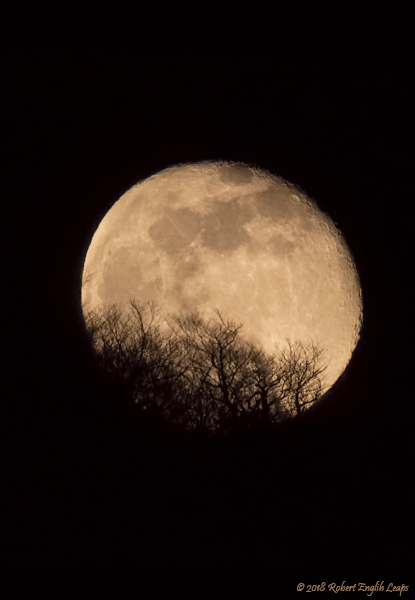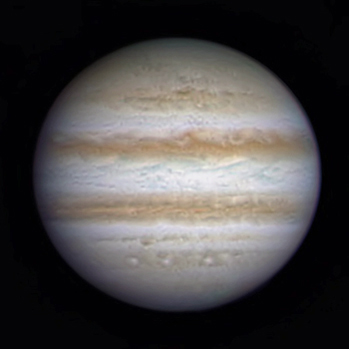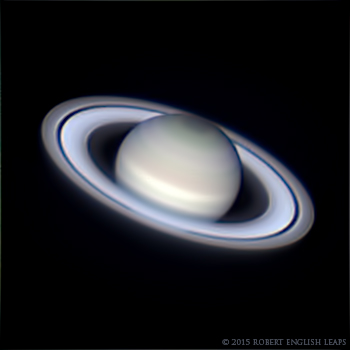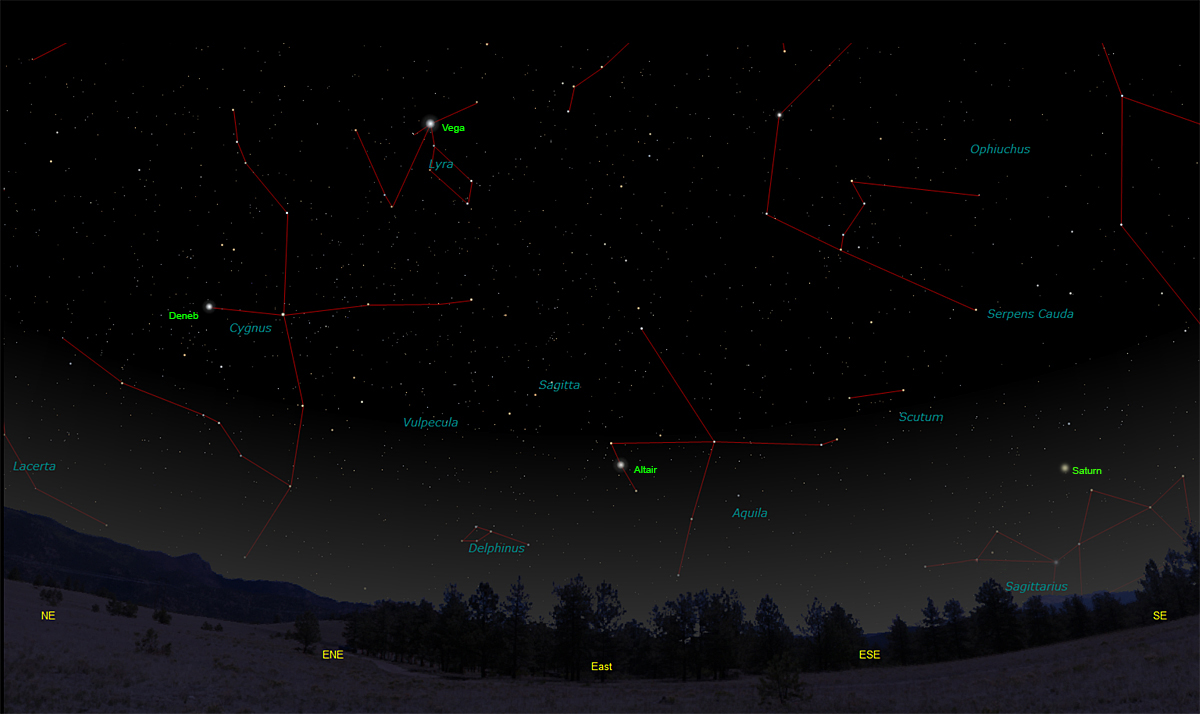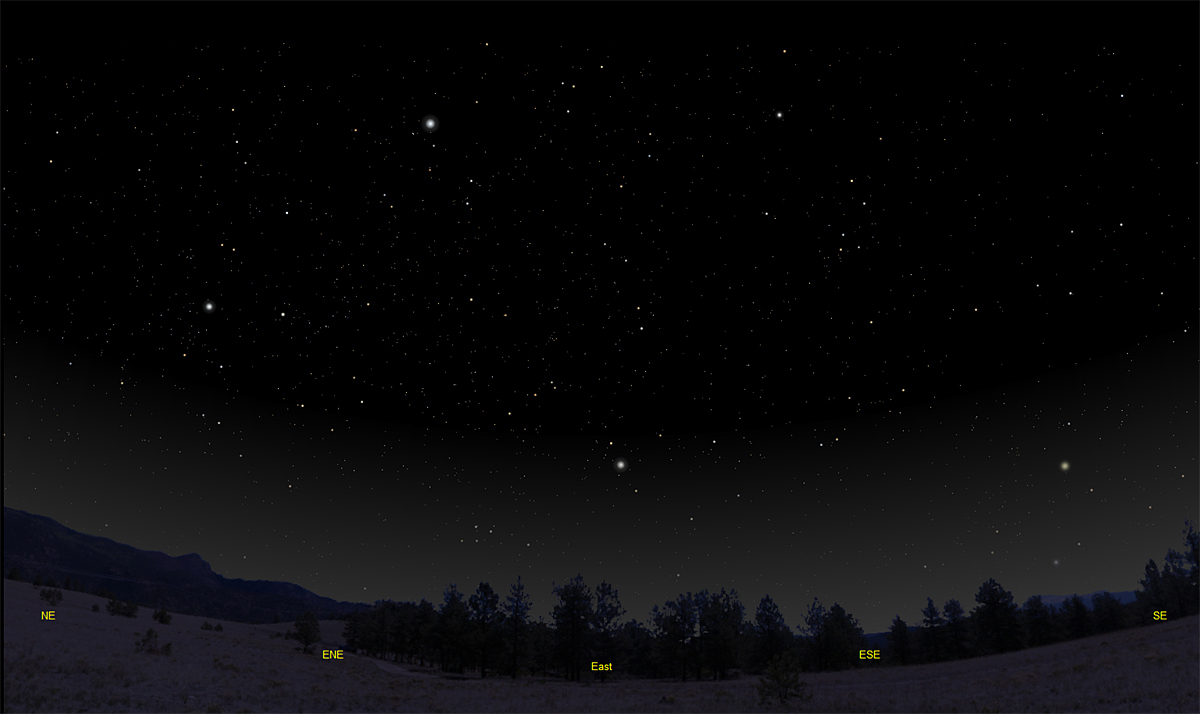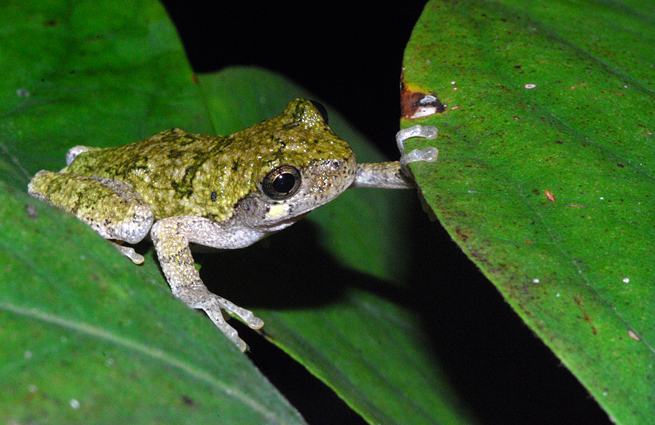The purpose of this feature is to give scout leaders, educators and naturalists an idea of some of the natural events coming up each month. We will try to cover a variety of natural events ranging from sky events to calling periods of amphibians, bird and mammal watching tips, prominent wildflowers and anything else that comes to mind. We will also note prominent constellations appearing over the eastern horizon at mid-evening each month for our area for those who would like to learn the constellations. If you have suggestions for other types of natural information you would like to see added to this calendar, let us know! Note: You can click on the hyperlinks to learn more about some of the featured items. To return to the Calendar, hit the "back" button on your browser, NOT the "back" button on the web page. All charts are available in a "printer friendly" mode, with black stars on a white background. Left clicking on each chart will take you to a printable black and white image. Please note that images on these pages are meant to be displayed at 100%. If your browser zooms into a higher magnification than that, the images may lose quality. Though we link book references to nationwide sources, we encourage you to support your local book store whenever possible.
Notes and Images From May 2018
The trailhead is around 4,500 feet in elevation, and it's a relatively easy 3.4 mile round-trip hike to Whigg Meadow and back. The meadow is at 5,000 feet. Most of the hike is a little lower than where I've encountered Saw-whet Owls before, but we thought it would be worth a try. It was a pretty night for the hike, and we set off down the trail as darkness approached. We listened at intervals for the owls, but heard none. We reached the meadow around 11:00pm. Still we heard no Saw-whets. As we walked up the trail that takes you to the crest of Whigg Meadow, we looked behind us and saw a waning gibbous moon rising over a ridge to the east. I hurriedly got out my camera and lens and readjusted all of the settings. Ack! The moon had cleared the ridge. But I realized since the ridge was sloping upward, I could go back down the trail and make it rise again! I managed to catch it rising over a different part of the ridge and just hoped I could hand-hold the camera steadily enough to get the shot. After that, we hiked to the top of the meadow and just enjoyed the panorama of sky and mountains. We slowly hiked back down the trail, just enjoying the night. We got back to the trailhead around 1:30am and started putting our packs and gear into the car. I walked over to a corner of the parking lot, and then I became aware of a faint sound right at the threshold of my hearing. I stopped, cupped my hands around my ears, and then there it was, very faint, coming and going, but plainly there: a Northern Saw-whet Owl! We listened, reveling in the beauty of the call. The short call notes, coming and going, had an ethereal quality in the cool night air. Was the owl turning its head when it called to make the notes vary? There was almost no wind at all. We imagined the owl on its perch, calling into the night. We savored the calls, the night air, the mountain ridges by moonlight. Then, reluctantly, we said goodbye and began the drive back down the mountain.
Sky Events for June 2018: The summer solstice is at 5:07am Central Daylight Time on June 21st, marking the beginning of summer in the Northern Hemisphere. This is our longest day of the year, and our shortest night. Evening Sky:
Jupiter is in Libra this month. Look for it in the southeastern sky after sunset as the month begins. If you steady your binoculars on something solid, you can often pick out several of the four Galilean satellites of Jupiter close to the planet. With a telescope, you can often glimpse some details in the clouds. These details change rapidly, and the details can look different from night to night. It's also fun to watch the Galilean satellites transit the face of the planet, or be eclipsed by the planet's shadow. Mars is in Capricornus as the month begins, rising around 11:40pm CDT. The planet is rapidly growing in apparent size as the Earth swings by it in late July. Mars begins the month at 15.3 arcseconds in diameter and increases to a wonderful 20.7 arcseconds in diameter by the end of the month. In late July Mars makes its closest approach to Earth in 15 years! Mars is always fascinating to view, but it takes patience to wait for the moments when the Earth's atmosphere steadies. Venus continues to dazzle in the western sky after sunset this month. It reaches its highest sunset altitude of the year on June 6th. Mercury makes an appearance in the evening sky this month, beginning to be visible around mid-month. Look for it low in the western sky about 30 to 40 minutes after sunset at the end of the month, below and to the right of bright Venus.
Saturn is in Sagittarius this month, rising about 9:40pm CDT at the beginning of the month. The tilt of the rings has now opened to 26 degrees, and the view is spectacular in any size telescope. The planet transits around 2:37am CDT. Saturn comes to opposition on the night of June 27th. The globe of Saturn is now 18.2 seconds of an arc. Constellations: The views below show the sky looking east at 10:00pm CDT on June 15th. The first view s hows the sky with the constellation outlined and names depicted. Star and planet names are in green. Constellation names are in blue. The second view shows the same scene without labels. New constellations this month in the eastern sky are Lyra, the Lyre, with its bright star Vega, Cygnus, the Swan, and Aquila, the Eagle. The bright stars Vega, Deneb and Altair form the "summer triangle." Looking to the north, the edge-on galaxy NGC 5907 rides high above the Little Dipper in Draco. This galaxy was discovered in 1788 by William Herschel. Most estimates place it at a distance of around 40 million light-years. Using averted vision, I've seen it as a faint narrow streak of light in my 85mm Televue refractor. A 6 inch telescope will give you a better view. As with all deep sky objects, you need a clear dark sky.
On Learning the Constellations: We advise learning a few constellations each month, and then following them through the seasons. Once you associate a particular constellation coming over the eastern horizon at a certain time of year, you may start thinking about it like an old friend, looking forward to its arrival each season. The stars in the evening scene above, for instance, will always be in the same place relative to the horizon at the same time and date each June. Of course, the planets do move slowly through the constellations, but with practice you will learn to identify them from their appearance. In particular, learn the brightest stars (like Altair and Vega in the above scene looking east), for they will guide you to the fainter stars. Once you can locate the more prominent constellations, you can "branch out" to other constellations around them. It may take you a little while to get a sense of scale, to translate what you see on the computer screen or what you see on the page of a book to what you see in the sky. Look for patterns, like the stars that make up the constellation Lyra.The earth's rotation causes the constellations to appear to move across the sky just as the sun and the moon appear to do. If you go outside earlier than the time shown on the charts, the constellations will be lower to the eastern horizon. If you observe later, they will have climbed higher. As each season progresses, the earth's motion around the sun causes the constellations to appear a little farther towards the west each night for any given time of night. If you want to see where the constellations in the above figures will be on July 15th at 10:00pm CDT, you can stay up till 12:00am CDT on June 15th and get a preview. The westward motion of the constellations is equivalent to two hours per month. Recommended: Sky & Telescope's Pocket Star Atlas is beautiful, compact star atlas. A good book to learn the constellations is Patterns in the Sky, by Hewitt-White. You may also want to check out at H. A. Rey's classic, The Stars, A New Way to See Them. For skywatching tips, an inexpensive good guide is Secrets of Stargazing, by Becky Ramotowski.
A good general reference book on astronomy is the Peterson
Field Guide,
A Field Guide to the Stars and Planets, by Pasachoff. The book retails for around $14.00.
The Virtual Moon Atlas is a terrific way to learn the surface features of the Moon. And it's free software. You can download the Virtual Moon Atlas here. Apps: We really love the Sky Safari 6 Pro. It is available for both iOS and Android operating systems. There are three versions. The Pro is simply the best astronomy app we've ever seen. The description of the Pro version reads, "includes over 100 million stars, 3 million galaxies down to 18th magnitude, and 750,000 solar system objects; including every comet and asteroid ever discovered." A nother great app is the Photographer's Ephemeris. Great for finding sunrise, moonrise, sunset and moonset times and the precise place on the horizon that the event will occur. Invaluable not only for planning photographs, but also nice to plan an outing to watch the full moon rise. Available for both androids and iOS.
Amphibians:
In June the treefrogs really hit their stride. Listen for Cope's Gray Treefrogs, Gray Treefrogs, Bird-Voiced Treefrogs, Green Treefrogs and Barking Treefrogs. Northern Cricket Frogs and Southern Cricket Frogs call a lot during June, and the calls of Bullfrogs, Green Frogs and Fowler's Toads fill the night air. After heavy rains listen for the high, insect-like call of the Eastern Narrowmouth Toad and the strange-sounding Eastern Spadefoot. Recommended: The Frogs and Toads of North America, Lang Elliott, Houghton Mifflin Co.
Birds: Now is a good time to get to know the breeding birds of Tennessee. It's fun to take a trip to the Great Smoky Mountains National Park in June and hike a high altitude trail, like the Alum Cave Bluff trail. By doing so you can encounter birds that breed in Tennessee at these higher elevations, like Black-throated Blue Warblers, Canada Warblers, Chestnut-sided Warblers and Blackburnian Warblers.
Archives (Remember to use the back button on your browser, NOT the back button on the web page!)
Natural Calendar February 2016 Natural Calendar December 2015 Natural Calendar November 2015 Natural Calendar November 2014 Natural Calendar September 2014 Natural Calendar September 2013 Natural Calendar December 2012 Natural Calendar November 2012 Natural Calendar September 2012 Natural Calendar February 2012 Natural Calendar December 2011 Natural Calendar November 2011 Natural Calendar September 2011 Natural Calendar December 2010 Natural Calendar November 2010 Natural Calendar September 2010 Natural Calendar February 2010 Natural Calendar December 2009 Natural Calendar November 2009 Natural Calendar September 2009 Natural Calendar February 2009 Natural Calendar December 2008 Natural Calendar November 2008 Natural Calendar September 2008 Natural Calendar February 2008 Natural Calendar December 2007 Natural Calendar November 2007 Natural Calendar September 2007 Natural Calendar February 2007 Natural Calendar December 2006 Natural Calendar November 2006 Natural Calendar September 2006 Natural Calendar February 2006
Natural Calendar December 2005
Natural Calendar November 2005
Natural Calendar September 2005
Natural Calendar February 2005
Natural Calendar December 2004
Natural Calendar November 2004
Natural Calendar September 2004
Natural Calendar February 2004
Natural Calendar December 2003
Natural Calendar November 2003 Natural Calendar February 2003 Natural Calendar December 2002 Natural Calendar November 2002 Nature Notes Archives: Nature Notes was a page we published in 2001 and 2002 containing our observations about everything from the northern lights display of November 2001 to frog and salamander egg masses. Night scenes prepared with The Sky Professional from Software Bisque All images and recordings © 2018 Leaps
|
|
